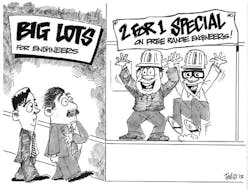Model Predictive Control - Past, Present and Future, Part 1
Stan: In this multipart part series Mark will share his thoughts on the scope of MPC applications, proper use of the regulatory level, inferential measurements, model development, economic objectives, support and maintenance. Since these Control Talk columns are designed to promote a creative capture of expertise, we use open-ended conversations rather than a script of questions so we are free to roam. You may have heard of free range chickens and how that makes for happier and tastier chickens. You can consider us free range engineers and while we may be happier than cooped up engineers, we hope not to end up at the meat counter even though upper management may just see us as bodies chewing up money better consumed as bonuses.
Greg: Where do we have MPC installations?
Mark: About 60% of MPC applications are in the refineries and petrochemicals (e.g., bulk chemical). Here the use of MPC is nearly an order of magnitude greater than advanced regulatory control (ARC). For specialty chemicals, MPC applications are growing and are approaching the number of ARC applications. MPC is moving into food processing and has even penetrated discrete manufacturing, most notably the automotive industry. If a chemical company has significant PID expertise, then ARC is often deployed. Large companies are more likely to consider MPC.
Stan: What is the success rate for new applications?
Mark: Success is nearly 100% in some plants, but is uneven despite significant advances in MPC software providing tools that previously required special programming and user skills. However, implementation naivety and disappointment has led some to reconsider the role of MPC. One of the problems is how do you go to get management support for a new APC application to get the right resources. Different silos make this difficult. A successful MPC application requires management to provide the operations training, regulatory control improvement and MPC expertise on a continuing basis. Even the best MPC software requires knowledgeable people to monitor and maintain the MPC application. Expertise must be readily accessible to insure the MPC performs well despite changes in process conditions and objectives and changes in instrumentation and equipment performance. Even if the MPC is not the cause of a problem, the MPC can be blamed. Also, operators may inadvertently disable the functionality of the MPC.
Stan: In the October Control 2012 Talk column "Bringing Advanced Process Control Home" we saw for industrial gas plants how important the support of a core company group was to success. We also had our eyes opened to how once a trustful relationship is established with operators, the MPC expert can be virtually rather than physically in the control room by remote PC applications and possibly cloud computing. What about batch operations?
Mark: While nearly all of the current applications are on continuous processes, we are seeing MPC applications in batch operations based on nonlinear hybrid models that incorporate both fundamental and empirical modeling techniques.
Greg: There are some highly successful linear MPC temperature control applications on batch distillation columns operating in a semi-continuous mode. For fed-batch reactor and bioreactor profile control, I have found that controlling the slope of the profile makes the response self-regulating and more linear. More importantly for product concentration control, using the slope of the batch profile as the controlled variable enables negative as well as positive changes that are essential for feedback control. The slope target is changed as the batch progresses.
Stan: Why do you think the role of MPC is increasing, and are there any cautionary words?
Mark: Black-box thinking has led to the conclusion that MPC is the total solution. Bottom up thinking is needed to make sure the measurements provide a good window into the process, and valves provide an effective means of affecting the process. Where flow measurement turndown meets requirements, flow control should be used so that the MPC does not have to deal with the nonlinearity of the control valve. Also, flow ratio control should be enforced in the regulatory control system so the MPC only has to correct the ratio instead of using flow as a disturbance variable. In the early days of MPC, cascades loops were often opened so the MPC could manipulate a flow setpoint, but it may be better to keep these cascades in place for disturbance rejection. For example, should the temperature control of a column or vessel stay within the regulatory control system?
Greg: If the controller gain and derivative settings are high, a PID probably is the best solution for rejecting unmeasured load disturbances. On the other hand, if there is more than one temperature control point (e.g., bottom and top distillation column temperature control or kiln inlet and outlet temperature control), the MPC could provide a more straightforward solution. The dynamic decoupling of PID controllers requires Shinskey type expertise that is increasingly in short supply. When I was teaching chemical engineers modeling and control, I found that the students could relate better to the MPC solution maybe because it emphasized steady-state gains, and the dynamics were automatically addressed by the software. In contrast, the PID solution required what seemed like largely undocumented expertise and special configuration skills. Guidance on the use of feed-forward gains and lead-lags and techniques for the moderation of the transfer of variability are scattered and incomplete, and the solution often special. Every solution being unique is great for the consulting business, but not so good for the plant stuck trying to make sure the advanced regulatory control continues to do its job.
Mark: While knowing dynamics is essential for PID control, getting the steady-state gains right is most important for an MPC. Steady-state thinking and knowledge starts in petrochemical and chemical engineering courses and is continued through the use of simulation software for process design. These steady-state gains are critical for analysis, prediction and optimization.
Stan: I realize the software today does a complete analysis and provides solutions, but what can we see in the steady gain matrix that is indicative of problems in the MPC design?
Mark: If the gains in a column of the process model matrix are similar, then the process input X variables (e.g., manipulated variables) may not be truly independent. Some of the inputs may need to be removed or the model reformulated. If the gains in one column exhibit a similar ratio to gains in another column, then the process output Y variables (e.g., controlled variables) are interrelated, or colinear. Obvious places to look include situations where manipulated variables have a nearly identical response in the controlled variables. A simple example would be multiple temperatures in a catalyst bed.
Greg: I have read that principal component analysis (PCA) can provide orthogonal principal components for the controlled variables, but there is a loss in operational recognition, and the PCA must be assured to be complete enough for closed-loop control. Plus I am not sure how process time constants are incorporated in the PCA results. The simple addition of delays to match the 63% response point would not appear to be sufficient for smooth predictive control over the time horizon. I think the integration of PCA in MPC merits research. What is being done today?
Mark: An approach for dealing with the interrelationships between manipulated and controlled variables is based on a singular value decomposition (SVD) of the gain matrix. A zero singular value corresponds to a 100% colinear relationship. The basic idea is to force small singular values to 0 and recalculate the gain matrix. The methods used in practice only treat the steady-state gains.
Stan: Since composition is often what you ultimately want to control, what do you do about missing or unreliable analyzers?
Mark: We use inferential measurements. Techniques such principle component regression (PCR) and partial least squares (PLS), which are akin to PCA, are useful for selecting the most significant components to use to develop an inferential predictor (a regression equation). Dynamic models linking manipulated variables to the inferential predictor are developed using the identification software employed by the MPC. These inferential measurements generally provide faster, smoother and more reliable composition measurements than analyzers. Consequently, even if an on-line or at-line analyzer is available, these inferential measurements provide better prediction and control. When there is only a lab analyzer, there is a temptation to think the inferential measurement can do the complete job. While some may state that automated correction by a lab analyzer is counterproductive, most would recognize feedback correction is necessary. The correction is often a bias that is a fraction of the error between the inferential measurement and an analyzer reading synchronized with the analyzer result. If the task of intelligent analysis and screening of lab signals is shortchanged, so that correction is not chasing noise or a resolution/sensitivity limit or reacting to bad sample handling, then the correction could do more harm than good, particularly in the short term. It is important to compare the raw inferential predictor (without update) to the analyzed value to gauge the accuracy of the inferential predictor,
Greg: I find it conceptually stupid to think you can have a model that predicts something that is never measured. We ran into this pipe dream when plants wanted to predict by neural networks something that is not measured. I guess this assures your model is always right. For me, process control and even life is all about feedback, otherwise we would be unstable.
Two Common Myths Advanced Process Control
Myth 1 – You need an advanced degree to do advanced control. Not so any more. New software packages can be used that take advantage of decades of knowledge gained in terms of the identification of models and resolving problems. The user can now focus mostly on the application and the goal.
Myth 2 – MPC is only applicable to continuous processes. Since most of the applications by far are in continuous process industries, this is a common misconception. While there is no steady-state in batch, MPC can do control of fed-batch columns and reactors. Also, the use of the slope of the profile of process variables such as temperature or concentration profile, as a controlled variable offers a continuous type of control. Varying targets and model switching is used to deal with changes in process dynamics and objectives as the batch progresses.
About the Author
Stan Weiner*
Contributor
Greg McMillan
Columnist
Greg K. McMillan captures the wisdom of talented leaders in process control and adds his perspective based on more than 50 years of experience, cartoons by Ted Williams and Top 10 lists.

Leaders relevant to this article:



